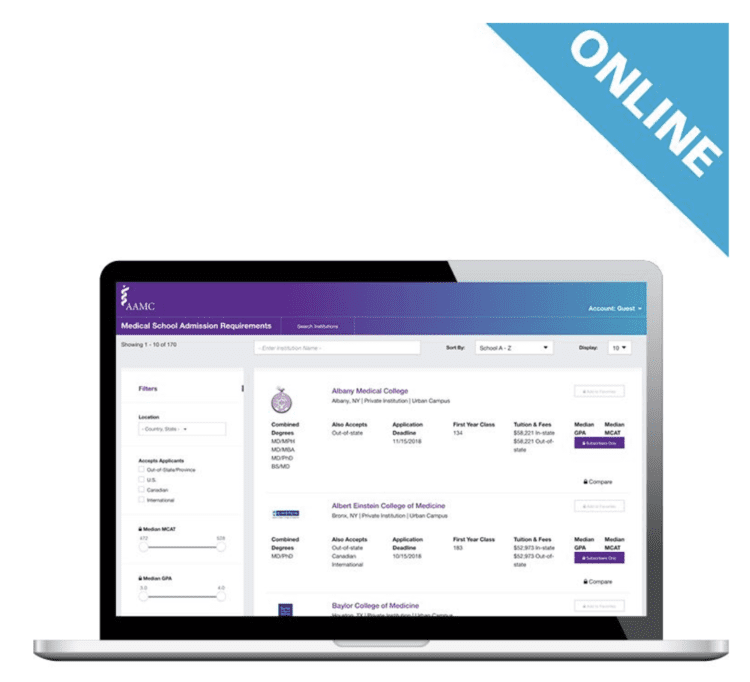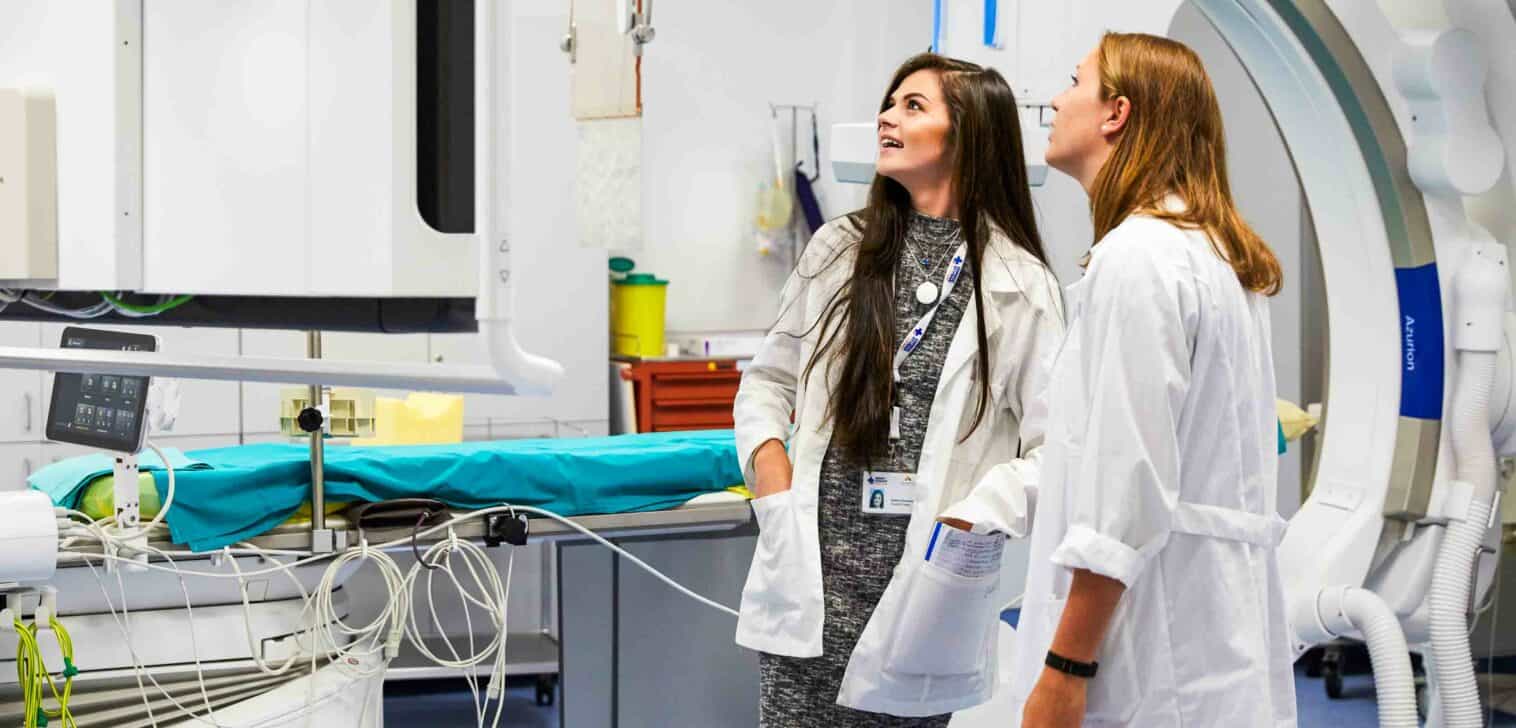
Applying to Med/PA School
An Insider’s Guide to Getting the Most From the MSAR
About Ryan
A native of Katonah, New York, Ryan is currently studying Philosophy, Chemistry and Biology at UNC Chapel Hill. After graduation, he hopes to earn his MD and Masters in Bioethics through a dual degree program, and then practice as a pediatrician while researching bioethics and health policy.
What is the MSAR?
Abbreviations are strewn like pebbles across the pre-med path. After you’ve mastered the MCAT, the AMCAS, and the AAMC, there’s the MSAR. Don’t let the last trip you up. Filled with powerful data, this tool can dramatically clarify the medical school application process. Let’s see how.

Short for “Medical School Admissions Requirements,” the MSAR is a complete collection of three years worth of statistics and information for a given medical school. It includes information on all MD and LCME-granting institutions in the United States and Canada. For me — the first in my family to apply to medical school — these kinds of insights are invaluable. It’s difficult to navigate in the dark; the MSAR helps illuminate the path so you can navigate it more dexterously.
What does the MSAR tell you?
The MSAR gives details for each school in these six areas: “Overview,” “Admissions,” “Acceptance Data,” “Education and Research,” “Tuition, Aid, and Debt,” and “Campus Life.” Let’s break them down by sections.
Overview:
If you’re early in your application process or looking to broaden your application pool, this section gives a great high-level glimpse. It contains information on whether a school is private or public (and, for the latter, whether it accepts out-of-state students), the median GPA and MCAT, tuition and fees, gender breakdown, and application deadlines.
Admissions:
This section includes information on the primary and secondary applications, such as deadlines, costs, and availability of fee waivers. (To learn more about the AMCAS application, read this). It also includes information on the minimum and maximum number of letters of recommendations permitted.
Here you’ll also find information on interviews, ranging from data about when interviews are offered, the types of interviews, and what to expect on interview day.
Acceptance Data:
This section covers MCAT and GPA scores (both overall and science GPA) of accepted and matriculated students in the 10th, 25th, 50th, 75th, and 90th percentile. It also has a student activity overview covering research, volunteer work, shadowing, and more. There is demographic information on gender, race and ethnicity, age, location, and desired specialty.
Education & Research:
Here you can uncover details about the curriculum and grading system, as well as information about research and patient-centered care opportunities for medical students.
Tuition, Aid & Debt:
MSAR compiles information about the cost of attendance (unfortunately, high), the percent of students receiving financial aid (fortunately, also high), and the average debt. You’ll also find information about potential scholarships and aid packages.
Campus Life:
This section discusses information related to housing, geographic location, student organizations, and diversity and inclusion initiatives.
How do I use it?
Your usage of the MSAR depends on your current life stage: “During Application,” “Year Prior to Application,” and “Early Years” (those prior to the year prior to the application). For someone who wants to enter medical school straight out of college, freshman and sophomore years would count as the “Early Years,” junior year would be the “Year Prior to Application,” and senior year would be “During Application.” For every gap year you take, simply push the “Year Prior to Application” and “During Application” forward.
Early Years:
In these years, the MSAR can help provide you with a lay of the land. You can gain a head start on medical school, glean insights and get an idea of how different pre-med profiles look.
The MSAR is a good tool for providing some direction regarding coursework; it can allow you to make plans regarding which classes to take and how to schedule them.
The MSAR also can help direct you to what kinds of activities are available (e.g. paid clinical work: something I was not aware of as an opportunity for undergraduates!) However, you should not use the MSAR to direct your activities. Just because 97 percent of the matriculants of a given medical school engaged in laboratory research doesn’t mean that you should too if you lack interest in that area. To be clear, the MSAR can guide you to medical schools that match your interests, but you shouldn’t try and mold your interests to fit a school. Find a place that fits your natural life mission and goals.
The MSAR can also alert you to “Special Programs,” which may include summer opportunities. These can be a great way to get an edge in advance of medical school!
Year Prior to Application
This is the time when you begin to put together the list of schools to which you will apply; thus, the MSAR is particularly helpful in this stage.

Begin by using the “Filter” function on the left-hand side of the MSAR to look for medical schools. You can narrow down your options by choosing location, median GPA, median MCAT, public vs. private, special degree programs (e.g. MD/PhD or MD/MPH), and class sizes. AAMC provides a step-by-step guide to help you find schools.
In general, when looking at acceptance data, it is important to remember that schools consider more than GPA and MCAT in their assessments. Just because your score falls below the median GPA doesn’t mean you shouldn’t apply to a particular school; similarly, an above-median MCAT score doesn’t guarantee your acceptance. Generally, Johns Hopkins pre-med advisors recommend that you aim for some schools whose median scores match yours, some whose fall above and some whose fall below. Keep in mind, however, that it’s usually helpful to remain between the 10th and 90th percentile, unless you have reason to think that you should move outside that range (e.g. an exceptional personal history or a special connection with that school).
After narrowing down your list, it’s also important to look at any differences between a school’s in-state and out-of-state acceptance statistics. Some schools, like UNC School of Medicine, do accept out-of-state applicants, but have significantly higher standards for them. You can find this information using the “Accepted Students Out-Of-State” feature in the “Acceptance Data” section. You can find geographic information under “Matriculation Data for First Year Class.” On this page, you will see “In-State,” “Out-of-State,” and “Total” numbers for each step of the process, from applicants to interviews to matriculants. Some schools will offer significantly more interviews to in-state students, which is important to keep in mind when selecting schools to which you’ll apply.
It can be tempting to draw hasty conclusions from the “Premedical Experience” figure in the “Admissions” section. It’s important to keep two things in mind: (1) Medical school admissions requirements and preferences are not static; they can change from year to year, and (2) Correlation is not causation. Just because a large percentage of matriculants conducted research does not make research the secret to gaining admittance to that school. In fact, an unknown third variable such as intellectual curiosity could be the real link.

However, for example, if 98 percent of accepted students have research experience, it is reasonable to assume that the school places emphasis on research. Studying the institution’s website can certainly clarify its areas of particular focus. In this example, if you don’t have research experience, it does not then signify that you should not apply. However, consider highlighting your other experiences that show similar skill-sets.
Finally, the MSAR is especially helpful for financial planning. Swarthmore College estimates that applicants will spend around $2,800 on fees alone. The MSAR has information about the fees associated with Secondary Applications, as well as geographic information so that you can plan accordingly for interviews. This allows you to make better financial decisions.
Year of Application
Congratulations! You found your schools, you wrote your personal statement, you submitted your AMCAS. Time to put your feet up and relax, right?
… and then the first secondary application arrives. Then the second. Then the next twelve. The MSAR becomes particularly handy at this point. Containing all the important deadlines for your various applications, it can even import them directly into your calendar.
The MSAR also includes information about a given medical school’s mission statement and general information. This can help beyond selecting a medical school to which you apply; you can use this to make sure you’re highlighting relevant aspects of your experience in your application. For example, if a school’s mission statement emphasizes research, this can help hone your secondary application and (knock on wood!) interview.
In the “Admissions” section, there is a sub-section covering interviews. This will inform you about what the interview day looks like and what type of interview (MMI, committee, etc.) you can expect. Talk to your career services team about this! They can help you with tailored practice interviews that match the school’s interview style while reflecting its mission.
Main Takeaways
The MSAR has a lot of information. Without a roadmap, you can easily spend an hour sifting through the sections of the tool and walk away having learned little to nothing truly helpful. However, if you enter the MSAR with a plan and use it wisely, it will be a fantastic and illuminating tool.
If you take nothing else away from this article, remember these three tips:
1. Don’t rule a school out just because of the MSAR. It’s a tool — not a crystal ball!
2. Look at the MSAR before you apply to make sure you have a good range of comfortable, target, and reach schools. Don’t just look at numbers; look at in-state and out-of-state information, mission statements, and common student activities.
3. Refer back to the MSAR while writing your secondaries and preparing for interviews. It’s a great way to “prime” yourself for which qualities you might want to discuss. (But, again, don’t change yourself to fit a mold!)
Our Alumni Enter Great Medical Schools

John Daines
- Atlantis '17
- Brigham Young University '19
- Washington U. in St. Louis MD '23


Zoey Petitt
- Atlantis '17
- U. of Arizona '18
- Duke MD '23

Zoey Petitt
Hungary ’17 || University of Arizona (undergraduate) ’18
Completed Atlantis Program Location and Date:
Hungary, Summer 2017
Do you believe your Atlantis experience helped you get into your graduate program?
I believe it was very helpful.
Generally, why do you think Atlantis helped you get into your graduate program?
For me, my Atlantis experience played a key role in confirming my decision to go into medicine. This was important for me to discuss during the admissions process.
Specifically, did you talk about Atlantis in your interviews?
Yes

Yong-hun Kim
- Atlantis '17
- Stanford '19
- Mayo Clinic MD '24

Yong-Hun Kim
Budapest, Hungary ’17 || Stanford University
Program:
Budapest, Hungary – Winter 2017
Undergraduate:
Stanford University class of 2019
Major:
Computer Science
Honors:
Bio-X Grant (award for research)
Undergraduate Activities:
President and Founder of Stanford Undergraduate Hospice and Palliative Care, Volunteer for Pacific Free Clinic, Research Assistant in Wernig Pathology Lab, President of Hong Kong Student Association, violin performance
Describe Atlantis in three words:
Eye-opening. Spontaneous. Exhilarating.
Why did you choose Atlantis?
I chose the Atlantis program because it combines opportunities to shadow physicians and travel abroad, both of which I had little prior exposure to.
What was your favorite experience as an Atlantis participant?
My favorite experience as an Atlantis participant came in the stories exchanged over meals or excursions and the breadth of conversation that reflected the diversity of backgrounds within our cohort and site managers.
What was the most meaningful aspect of your time shadowing?
I appreciated the chance to speak with physicians in Budapest and hear their personal motivations for pursuing medicine because it really helped better contextualize and validate my own interest in medicine. The physicians were also just really welcoming, relatable, and down-to-earth people.
How has Atlantis helped equip you for the future?
The Atlantis program has equipped me with a better understanding of what a career in medicine looks like, which I think is an invaluable gift considering the long road ahead of those who aspire to be a physician.
How has Atlantis equipped you for active leadership in the medical field?
The ability to interact and empathize with patients of diverse backgrounds and communities is a necessity to be a leader in the medical field. I think the Atlantis program, through my interactions with mentors and their patients, has helped me take my first steps toward attaining the cultural vocabulary and literacy required of a physician.

Megan Branson
- Atlantis '18
- U. of Montana '19
- U. of Washington MD '24


Sarah Emerick
- Atlantis '19
- Eckerd College '20
- Indiana U. MD '25


Snow Nwankwo
- Atlantis '19
- Catholic U. of America '21
- Georgetown U. MD '26


Tiffany Hu
- Atlantis '16
- U. of Maryland '17
- U. of Michigan MD '22

Tiffany Hu
Tereul, Spain ’16 || U Michigan Medical School
Program:
Teruel, Spain – Summer 2016
Undergraduate:
University of Maryland class of 2017
Admitted medical student at:
University of Michigan Medical School
Major:
Neurobiology
Honors:
Honors Integrated Life Sciences Program, Banneker/Key Scholarship
Extracurricular Activities:
American Medical Student Association Co-President & Advocacy Day Liaison, Alternative Breaks Experience Leader, Health Professions Advising Office Student Advisory Board, Biology Teach Assistant, Health Leads, Buddhist Tzu Chi Foundation, NIH Research Intern, Physicians for Social Responsibility Environment & Health Intern
Describe Atlantis in Three Words:
Educational. Eye-opening. Exhilarating.
Why did you choose Atlantis?
I wanted to expand my horizons and understand a culture of health different from the ones I am accustomed to. I had shadowed doctors in the United States and Taiwan prior to my Atlantis program experience, and being able to see first-hand the healthcare system in Spain allowed me to draw comparisons between the different complex healthcare systems.
What was your favorite experience as an Atlantis participant?
Bonding with the other participants and celebrating our time together along with the doctors we shadowed. We would discuss our interests, passions, and motivation for medicine, and it was an incredible experience to learn from and alongside them.
What was your experience with the doctors you were shadowing?
Because of the pre-established relationships with the hospitals in which we shadowed, all the doctors were very welcoming and accommodating. They were willing to translate for us and explain in detail all of their medical decisions. My doctors and I had wonderful conversations about the differences between life in Spain vs. the United States.
What was the most meaningful aspect of your time shadowing?
I was excited to scrub in on surgeries and watch as the doctor explained what he was doing throughout the operation. Before and after surgeries, as well as in my other rotations, I observed how the doctors reassured and communicated with their patients. I was able to glean insight into differences between the experience of health in Spain versus the United States through observation as well as conversations with the doctors.
How has Atlantis helped equip you for the future?
Besides the wealth of medical knowledge I gained from shadowing the doctors, I challenged myself to step outside of my cultural comfort zone and explore more than I thought I was capable of. Atlantis allowed me to make connections with people from all around the United States and abroad, and the friendships I gained helped me learn so much more than I would have on my own.

Lauren Cox
- Atlantis '18
- Louisiana Tech '20
- U. of Arkansas MD '24

Lauren Cox
Libson, Portugal ’18 || Louisiana Tech
Completed Atlantis Program Location(s):
Lisbon, Portugal
Year of most recent program:
Fall ’17 – Summer ’18
Season of most recent program:
Summer
Do you believe your Atlantis experience helped you get into your graduate program?
Extremely helpful
Generally, why do you think Atlantis helped you get into your graduate program?
It exposed me to shadowing that was hard to come by in the states. It also gave me a chance to see other systems of healthcare.
Specifically, did you talk about Atlantis in your interviews? If so, how much relative to other topics?
Yes – they wanted to know about my experience, and specifically how the healthcare I saw in another country compared to what I had seen in the USA.

Kayla Riegler
- Atlantis '18
- U. of Kentucky '20
- U. of Kentucky MD '24

About Atlantis
Atlantis is the leader in pre-health shadowing and clinical experience, offering short-term programs (1-10 weeks) over academic breaks for U.S. pre-health undergraduates. Medical schools want 3 things: (1)healthcare exposure, (2)GPA/MCAT, and (3)certain competencies. Atlantis gives you a great version of (1), frees you to focus on (2), and cultivates/shows (3) to medical school admissions committees.

Watch Video: The Atlantis Shadowing Experience and How it Helps In Your Med/PA Admissions Future

Two Atlantis alumni admitted to Top 5 MD programs wrote our widely read medical school admissions guidebook — download yours.
Get our 76-page medical school admissions guidebook, by Atlantis alumni at Harvard Medical School and Stanford School of Medicine.












